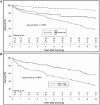Ten-Year Outcomes and Predictors of Mortality Following Catheter Ablation of Ventricular Tachycardia
- PMID: 39719410
- PMCID: PMC12054481
- DOI: 10.1161/JAHA.124.034814
Ten-Year Outcomes and Predictors of Mortality Following Catheter Ablation of Ventricular Tachycardia
Abstract
Background: Catheter ablation is the primary treatment option for idiopathic ventricular tachycardia (VT). It plays a key role in acute therapy of electrical storm, treatment of VTs in patients with structural heart disease (SHD), and can reduce VT burden. Here we report on 10-year clinical outcomes following VT ablation from patients enrolled in the prospective German Ablation Registry.
Methods and results: Long-term follow-up was conducted on 334 patients undergoing VT ablation (118/334, 35%) with structurally normal hearts and 216 out of 334 (65%) with SHD, including 161 out of 216 (75%) with ischemic heart disease at 38 centers. Follow-up was completed in 94.8% of patients. Median observation time was 10.8 (4.3-12.3) years, with a 10-year all-cause mortality rate of 39.4%. VT ablation in patients with SHD was associated with worse outcome when compared with patients with structurally normal hearts (estimated 10-year mortality for SHD 54.8% versus structurally normal hearts 12.1%). Estimated 10-year mortality following VT ablation was highest in patients with ischemic heart disease (62.4%). Significant predictors of mortality following VT ablation included age (hazard ratio [HR], 2.35 [1.90-2.92] per decade), left ventricular ejection fraction ≤30% (HR, 2.11 [1.44-3.10]), diabetes (HR, 1.73 [1.14-2.61]), incessant VT (HR, 2.96 [1.74-5.03]), linear lesion (HR, 1.46 [0.99-2.16]), and acute procedural failure (HR, 2.57 [1.39-4.77]). Procedural failure was the only statistically significant predictor for VT recurrence during follow-up (HR, 3.76 [1.59-8.91]).
Conclusions: Within an all-comer patient cohort, estimated 10-year all-cause mortality following VT ablation is 39.4%. Mortality after VT ablation is worse in patients with SHD and highest for patients with ischemic heart disease. Acute procedural success plays a major role in predicting VT recurrence and long-term mortality.
Keywords: catheter ablation; long‐term mortality; ventricular tachycardia.
Figures




References
-
- Zeppenfeld K, Tfelt‐Hansen J, de Riva M, Winkel BG, Behr ER, Blom NA, Charron P, Corrado D, Dagres N, De Chillou C, et al. 2022 ESC guidelines for the management of patients with ventricular arrhythmias and the prevention of sudden cardiac death. Eur Heart J. 2022;43:3997–4126. doi: 10.1093/eurheartj/ehac262 - DOI - PubMed
-
- Moss AJ, Greenberg H, Case RB, Zareba W, Hall WJ, Brown MW, Daubert JP, McNitt S, Andrews ML, Elkin AD. Long‐term clinical course of patients after termination of ventricular tachyarrhythmia by an implanted defibrillator. Circulation. 2004;110:3760–3765. doi: 10.1161/01.CIR.0000150390.04704.B7 - DOI - PubMed
Publication types
MeSH terms
LinkOut - more resources
Full Text Sources

